+ Open data
Open data
- Basic information
Basic information
| Entry | Database: PDB / ID: 1nkp | ||||||
|---|---|---|---|---|---|---|---|
| Title | Crystal structure of Myc-Max recognizing DNA | ||||||
 Components Components |
| ||||||
 Keywords Keywords | TRANSCRIPTION/DNA / TRANSCRIPTION / DNA / bHLHZ / oncogene / heterodimer / TRANSCRIPTION-DNA COMPLEX | ||||||
| Function / homology |  Function and homology information Function and homology informationMad-Max complex / positive regulation of metanephric cap mesenchymal cell proliferation / positive regulation of acinar cell proliferation / acinar cell proliferation / negative regulation of transcription initiation by RNA polymerase II / SCF ubiquitin ligase complex binding / NK T cell proliferation / Myc-Max complex / regulation of somatic stem cell population maintenance / regulation of cell cycle process ...Mad-Max complex / positive regulation of metanephric cap mesenchymal cell proliferation / positive regulation of acinar cell proliferation / acinar cell proliferation / negative regulation of transcription initiation by RNA polymerase II / SCF ubiquitin ligase complex binding / NK T cell proliferation / Myc-Max complex / regulation of somatic stem cell population maintenance / regulation of cell cycle process / Binding of TCF/LEF:CTNNB1 to target gene promoters / cellular response to interferon-alpha / RNA polymerase II transcription repressor complex / myotube differentiation / positive regulation of B cell apoptotic process / RUNX3 regulates WNT signaling / TFAP2 (AP-2) family regulates transcription of cell cycle factors / negative regulation of cell division / negative regulation of monocyte differentiation / detection of mechanical stimulus involved in sensory perception of sound / response to growth factor / response to alkaloid / B cell apoptotic process / transcription regulator activator activity / protein-DNA complex disassembly / Transcription of E2F targets under negative control by DREAM complex / negative regulation of stress-activated MAPK cascade / fibroblast apoptotic process / Regulation of NFE2L2 gene expression / positive regulation of mesenchymal cell proliferation / regulation of telomere maintenance / middle ear morphogenesis / skeletal system morphogenesis / Signaling by ALK / branching involved in ureteric bud morphogenesis / negative regulation of gene expression via chromosomal CpG island methylation / pigmentation / rRNA metabolic process / Transcriptional Regulation by E2F6 / positive regulation of telomere maintenance / E-box binding / MLL1 complex / positive regulation of intrinsic apoptotic signaling pathway by p53 class mediator / skeletal muscle cell differentiation / positive regulation of transcription initiation by RNA polymerase II / chromosome organization / negative regulation of fibroblast proliferation / core promoter sequence-specific DNA binding / Cyclin E associated events during G1/S transition / Cyclin A:Cdk2-associated events at S phase entry / ERK1 and ERK2 cascade / positive regulation of epithelial cell proliferation / transcription coregulator binding / SMAD2/SMAD3:SMAD4 heterotrimer regulates transcription / G1/S transition of mitotic cell cycle / euchromatin / protein-DNA complex / MAPK6/MAPK4 signaling / protein processing / NOTCH1 Intracellular Domain Regulates Transcription / positive regulation of miRNA transcription / DNA-binding transcription repressor activity, RNA polymerase II-specific / Constitutive Signaling by NOTCH1 PEST Domain Mutants / Constitutive Signaling by NOTCH1 HD+PEST Domain Mutants / RNA polymerase II transcription regulator complex / spindle / cellular response to xenobiotic stimulus / Wnt signaling pathway / Transcriptional regulation of granulopoiesis / positive regulation of fibroblast proliferation / intrinsic apoptotic signaling pathway in response to DNA damage / sequence-specific double-stranded DNA binding / cellular response to UV / MAPK cascade / regulation of gene expression / DNA-binding transcription activator activity, RNA polymerase II-specific / Interleukin-4 and Interleukin-13 signaling / cellular response to hypoxia / DNA-binding transcription factor binding / Estrogen-dependent gene expression / intracellular iron ion homeostasis / transcription by RNA polymerase II / DNA-binding transcription factor activity, RNA polymerase II-specific / protein dimerization activity / Ub-specific processing proteases / nuclear body / RNA polymerase II cis-regulatory region sequence-specific DNA binding / chromatin remodeling / response to xenobiotic stimulus / DNA-binding transcription factor activity / axon / positive regulation of cell population proliferation / DNA damage response / dendrite / ubiquitin protein ligase binding / positive regulation of gene expression / regulation of transcription by RNA polymerase II / negative regulation of apoptotic process / chromatin / positive regulation of DNA-templated transcription Similarity search - Function | ||||||
| Biological species |  Homo sapiens (human) Homo sapiens (human) | ||||||
| Method |  X-RAY DIFFRACTION / X-RAY DIFFRACTION /  SYNCHROTRON / Phased translation search / Resolution: 1.8 Å SYNCHROTRON / Phased translation search / Resolution: 1.8 Å | ||||||
 Authors Authors | Nair, S.K. / Burley, S.K. | ||||||
 Citation Citation |  Journal: Cell(Cambridge,Mass.) / Year: 2003 Journal: Cell(Cambridge,Mass.) / Year: 2003Title: X-ray structures of Myc-Max and Mad-Max recognizing DNA: Molecular bases of regulation by proto-oncogenic transcription factors Authors: Nair, S.K. / Burley, S.K. | ||||||
| History |
|
- Structure visualization
Structure visualization
| Structure viewer | Molecule:  Molmil Molmil Jmol/JSmol Jmol/JSmol |
|---|
- Downloads & links
Downloads & links
- Download
Download
| PDBx/mmCIF format |  1nkp.cif.gz 1nkp.cif.gz | 136 KB | Display |  PDBx/mmCIF format PDBx/mmCIF format |
|---|---|---|---|---|
| PDB format |  pdb1nkp.ent.gz pdb1nkp.ent.gz | 101.1 KB | Display |  PDB format PDB format |
| PDBx/mmJSON format |  1nkp.json.gz 1nkp.json.gz | Tree view |  PDBx/mmJSON format PDBx/mmJSON format | |
| Others |  Other downloads Other downloads |
-Validation report
| Summary document |  1nkp_validation.pdf.gz 1nkp_validation.pdf.gz | 407.9 KB | Display |  wwPDB validaton report wwPDB validaton report |
|---|---|---|---|---|
| Full document |  1nkp_full_validation.pdf.gz 1nkp_full_validation.pdf.gz | 419.6 KB | Display | |
| Data in XML |  1nkp_validation.xml.gz 1nkp_validation.xml.gz | 9.9 KB | Display | |
| Data in CIF |  1nkp_validation.cif.gz 1nkp_validation.cif.gz | 18.1 KB | Display | |
| Arichive directory |  https://data.pdbj.org/pub/pdb/validation_reports/nk/1nkp https://data.pdbj.org/pub/pdb/validation_reports/nk/1nkp ftp://data.pdbj.org/pub/pdb/validation_reports/nk/1nkp ftp://data.pdbj.org/pub/pdb/validation_reports/nk/1nkp | HTTPS FTP |
-Related structure data
| Related structure data |  1nlwC  1an2S S: Starting model for refinement C: citing same article ( |
|---|---|
| Similar structure data |
- Links
Links
- Assembly
Assembly
| Deposited unit | 
| ||||||||
|---|---|---|---|---|---|---|---|---|---|
| 1 | 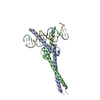
| ||||||||
| 2 | 
| ||||||||
| Unit cell |
|
- Components
Components
| #1: DNA chain | Mass: 5805.760 Da / Num. of mol.: 4 / Source method: obtained synthetically #2: Protein | Mass: 10468.156 Da / Num. of mol.: 2 / Fragment: bHLHZ region Source method: isolated from a genetically manipulated source Source: (gene. exp.)  Homo sapiens (human) / Gene: Myc / Species (production host): Escherichia coli / Production host: Homo sapiens (human) / Gene: Myc / Species (production host): Escherichia coli / Production host:  #3: Protein | Mass: 9795.012 Da / Num. of mol.: 2 / Fragment: bHLHZ region Source method: isolated from a genetically manipulated source Source: (gene. exp.)  Homo sapiens (human) / Gene: Max / Species (production host): Escherichia coli / Production host: Homo sapiens (human) / Gene: Max / Species (production host): Escherichia coli / Production host:  #4: Water | ChemComp-HOH / | |
|---|
-Experimental details
-Experiment
| Experiment | Method:  X-RAY DIFFRACTION / Number of used crystals: 1 X-RAY DIFFRACTION / Number of used crystals: 1 |
|---|
- Sample preparation
Sample preparation
| Crystal | Density Matthews: 2.23 Å3/Da / Density % sol: 44.95 % | ||||||||||||||||||||||||||||||||||||||||||||||||||||||
|---|---|---|---|---|---|---|---|---|---|---|---|---|---|---|---|---|---|---|---|---|---|---|---|---|---|---|---|---|---|---|---|---|---|---|---|---|---|---|---|---|---|---|---|---|---|---|---|---|---|---|---|---|---|---|---|
| Components of the solutions |
| ||||||||||||||||||||||||||||||||||||||||||||||||||||||
| Crystal grow | *PLUS Temperature: 15 ℃ / pH: 6.5 / Method: vapor diffusion, hanging drop | ||||||||||||||||||||||||||||||||||||||||||||||||||||||
| Components of the solutions | *PLUS
|
-Data collection
| Diffraction source | Source:  SYNCHROTRON / Site: SYNCHROTRON / Site:  APS APS  / Beamline: 19-ID / Wavelength: 0.91 Å / Beamline: 19-ID / Wavelength: 0.91 Å |
|---|---|
| Detector | Detector: CCD |
| Radiation | Protocol: SINGLE WAVELENGTH / Monochromatic (M) / Laue (L): M / Scattering type: x-ray |
| Radiation wavelength | Wavelength: 0.91 Å / Relative weight: 1 |
| Reflection | Resolution: 1.8→20 Å / Num. obs: 49228 / % possible obs: 95.9 % / Observed criterion σ(I): 4 / Rmerge(I) obs: 0.053 |
| Reflection | *PLUS Num. measured all: 276421 |
| Reflection shell | *PLUS % possible obs: 90.9 % |
- Processing
Processing
| Software |
| ||||||||||||||||||||
|---|---|---|---|---|---|---|---|---|---|---|---|---|---|---|---|---|---|---|---|---|---|
| Refinement | Method to determine structure: Phased translation search Starting model: PDB ENTRY 1AN2 Resolution: 1.8→20 Å / Cross valid method: THROUGHOUT / σ(F): 2 / Stereochemistry target values: Engh & Huber
| ||||||||||||||||||||
| Displacement parameters |
| ||||||||||||||||||||
| Refinement step | Cycle: LAST / Resolution: 1.8→20 Å
| ||||||||||||||||||||
| Refine LS restraints |
| ||||||||||||||||||||
| Xplor file |
| ||||||||||||||||||||
| Refinement | *PLUS Lowest resolution: 20 Å / % reflection Rfree: 10 % | ||||||||||||||||||||
| Solvent computation | *PLUS | ||||||||||||||||||||
| Displacement parameters | *PLUS | ||||||||||||||||||||
| Refine LS restraints | *PLUS
|
 Movie
Movie Controller
Controller



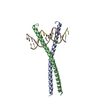
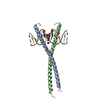
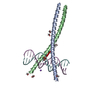
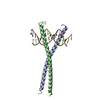

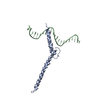
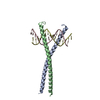
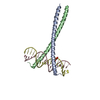
 PDBj
PDBj













































